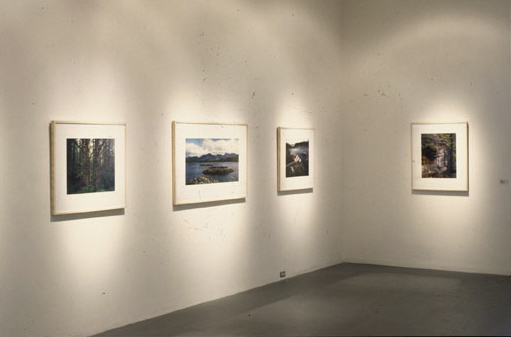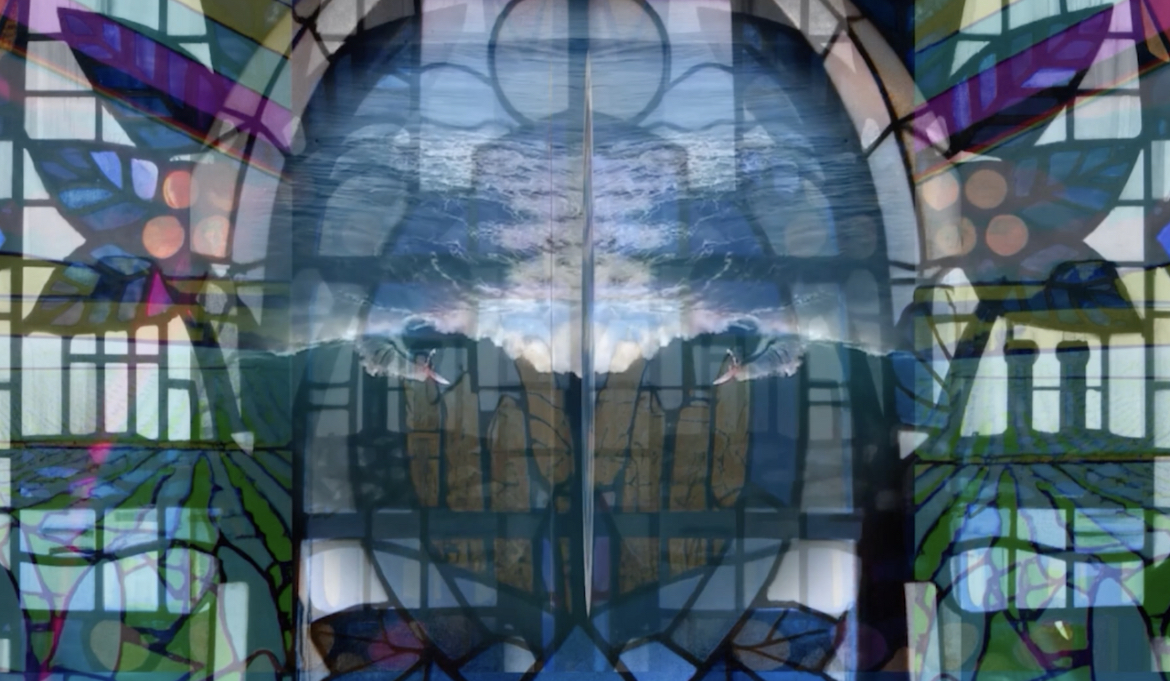- Rough Bush
- Rough Bush
- Rough Bush
- Rough Bush
Rough Bush
Patricia Deadman, Stan Douglas, Deanna Ferguson, Philippe Raphanel, Lawrence Paul Yuxweluptun
13 July–
10 August 1996
Curated by: Reid Shier


Rough Bush, exhibition at Or Gallery, 1996.


Rough Bush, exhibition at Or Gallery, 1996.
Rough Bush
Patricia Deadman, Stan Douglas, Deanna Ferguson, Philippe Raphanel, Lawrence Paul Yuxweluptun
Curated by: Reid Shier
The OR Gallery is proud to present Rough Group, a group exhibition with Patricia Deadman [Ontario], Stan Douglas, Deanna Ferguson, Philippe Raphanel and Lawrence Paul Yuxweluptun [Vancouver], describing contemporary practices, both written and visual, toward the social specificity of land use. Timed to coincide with the mammoth Group of Seven exhibition at the Vancouver Art Gallery, Rough Bush investigates the collision of differing cultural claims and competing mythologies to the Canadian landscape. Through a grouping of five artists who foreground the historical, social and economic legacies which have and continue to define land for very specific interests, it critiques an historical vision, buttressed by the mythos of nationalist art, that presupposes early Canada as an exploitable tabla rasa.
Profit-sized pink came azure
met silver of some virtues set in rock
unloosened with iron. this was none for me I
did not answer. But would have
would there were a way to crumbel.
Blend them. Nipped the loot thither.
Beyond cool snow lilies what was much
as love to see upon might tether.
Deanna Ferguson
From Rough Bush
Land of the Free
Words such as wilderness, forest, nature and bush collectively describe, if often haphazardly the world beyond the city’s frontiers. The word landscape, used to describe the visual and literary representations of such places, powerfully connotes their centrality within a western imaginative tradition. Such words describe civilization’s other, a fictive realm beyond the prosaic particularities of urban struggle; above all, they delineate a zone of strict ideological neutrality. Considerations of the use to which a forest or wilderness might be put, whether through resource extraction or its ideological opposite, eco-tourism, generally fall outside descriptions of the place itself. The land can be logged, hunted in, hiked through, photographed, painted, viewed, or left alone, but from the city’s vantage it remains “outside”, mysteriously beyond and above economic exigencies. Unlike land in the cities, the wilderness is presumed to be held in a kind of common trust, preserved by an act of collective regard. An example of the results of such attitudes occurred during the last week of June. When activists from Greenpeace attempted to blockade logging operations in Clayoquot Sound, the Nuu-chah-nulth chiefs evicted them for not first asking permission to mount their protest. Though the activists morally separate themselves from the uses to which the land was put, they cannot so easily transcend a view of it as common cultural property, equally accessible to all, as essentially unreflective as the loggers whose livelihoods they seek to eradicate.
Why, therefore, do words such as wilderness and forest, which would appear to be merely descriptive and neutral, evoke not only the places they denote, but imply a transcendence of the social and economic realms? Cities, within our present economies, are understood to be local and temporal sites of competing claims based in exchanges of capital and subject to fluxes in power, status, and class division. Why is the natural world presumed to be above these structures? The fact that an ecosystem can be, although is rarely anymore, a self governing system, means little when seen in the light of the pervasiveness of human intervention. Simply because the natural world is not a densely human social arena does not place it outside a political economy. The bush, like all real estate, is owned.
So to ask why the wilderness is a site of such imaginary freedoms is to ask why such freedoms are seen as necessary. One answer posits the city dweller as a circumscribed and limited individual, bound to the strictures of work, beholden to social and cultural parameters usually outside of her or his direct control. In opposition are the limitless forests beyond the city gates, the vast and liminal spaces of the wilderness, where social control is distant and unimportant, where the relationship of person and environment is unmediated and free. In this model the forest acts as counterpoint and balm to city pressures, a place where the weary citizen can recharge psychic batteries and return to the workplace recharged and recreated.
But if this trope rests on the assumption that there exists some type of freedom in the wilderness, that the forest can offer something which the city can’t, then what, other than it being the ‘not city’ does this mythology rest on? If the wilderness were simply a place without buildings, a big gravel field, who would go? Obviously the forest’s attractions are not a moot point, and I, like a lot of people I imagine, have felt awe and wonder, replete with a desire for preservation, when standing in front of a thousand year old Cedar or a forest of Arbutus. But seeing something which I don’t usually see, and wishing that it not be destroyed, can’t be the crux of the matter, it brushes over the powerful place which the wilderness as a whole holds in a civic, especially. western, imagination. What, other than an alternate ecology does it offer? What happens during the encounter between a person living in the city and a landscape outside of it?
The fact that this relationship is often spoken of (but rarely experienced) as a solitary one is a key clue to its meaning. Nature books and guides, travel magazines and tourist brochures all speak about an experience of the wilderness as one which makes a person seem small in comparison to the grandeur and expanse of nature. The awe and wonder of standing in front of thousand year old Cedar is not simply because I rarely see it, but because it makes me feel minuscule in comparison to its age and size. There is an active pursuit of spaces where one is overcome by feelings of incidentalness, of being lost within something overpowering, of gaining a sense of something outside and beyond the corporal body.
And by pursuing an experience which mitigates feelings of individuality of sensing there is something else, it paradoxically confirms a notion that that individuality exists. By being in a place which underscores an individual relationship with a larger whole, it confirms a feeling, essential to life in the city, that there is such a thing as individual agency. Within a culture which rests on an ideology of free individualism in order to justify and sanctify its economy, where individual enterprise is the grand mythology of North American society-where’ anyone’, if they work hard enough, can succeed-a notion of individualism must be fostered. The idea of a wilderness outside the city consolidates the individualistic ego by offering it an imaginative place to reside.
Of course in order for this grand metaphor to succeed, the wilderness can’t therefore be claimed by someone else. It must remain common property. The reason 67% of British Columbians responded to a February Insight Canada pole about land claims by saying they thought aboriginal peoples were being unreasonable has probably little to do with whether or not any of them will ever step foot on the areas being contested. They would simply rather not have someone other than ‘their government’ and by extension them, exert any claim to the ‘wilderness’. Knowing that this land is in fact someone else’sthough if they asked they would probably encounter little difficulty in enjoying it-destroys the most important, and most fallacious, mythology of all, that the wilderness is a place unclaimed, a place which beckons whenever one might tire of the office and need a little “recharging”, a place where individuality can roam, rampantly, free.
Reid Shier, July 1996
Speak yet again tho who old cloud O
Lord thy north word rejoice with grain again.
Financially infinite. Price distant then cost disappeared,
muddle through, all night, liver pool, several degrees
different still.
Deanna Ferguson
From Rough Bush
I would like to thank the artists who have graciously agreed to participate in this exhibition: Patricia Deadman, Stan Douglas, Philippe Raphanel, Lawrence Yuxweluptun and Deanna Ferguson. A special thanks to Deanna for the us of “Rough Bush” for the title of show. finally my thanks to Robert Linsley for his postcards, to Jake and Maryon Adelaar and Glenn Alteen who loaned works for the exhibition, and to Bob MacIntyre, Jen Hamilton, Helen Geddes, Steve Shearer and Peter Culley, whose help has been invaluable.
Reid Shier




